Emoji, Text, and Sentiment Polarity Detection Using Natural Language Processing
Abstract
1. Introduction
- Introducing a novel cognitive paradigm of sentiment polarity computing framework based on parser generation by deconstructing the natural language concepts of online sentiments into text and emoji;
- To propose a cognitive sentence level polarity detection using enormous complex pattern rules for employing the linguistic features of the modern online natural language, i.e., emoji in conjunction with text, text with multiple emojis, emoji only, and text only;
- To familiarize with extensive rules of pattern-based coordinated, discourse, and polarity inversion structures of online natural-language sentiment polarity-detection generator;
- The evaluation of the introduced approach is based on three distinctive classifiers: Naïve Bayes, support vector machine, and decision tree with three proposed online linguistic features with emojis, in conjunction with text, text with multiple emojis, emoji only, and text only;
- To determine which, among the three classifiers, works well with our proposed approach;
- To conduct extensive experiments with complex sentences to implicate the robustness and effectiveness of the suggested text and emoji-based sentiment polarity detection approach.
2. Related Work
| Approach | Linguistic Features | Approach Used/ Classifier Used | Dataset | Accuracy |
|---|---|---|---|---|
| Poria et al. [31] | Text | SenticLDA, dependency trees, bag of words. | 235,793 hotel reviews obtained from the hotel’s review site tripadvisor.com, Semeval-2014 | Precision of 88.25% for Semeval-2014 dataset |
| Dragoni et al. [32] | Text | SenticConcept, Domain, Polarity Instance, and Resource. | A semantic network of 100,000 concepts | - |
| Ma et al. [33] | Text | Sentic LSTM | Semeval-2015, Sentihood | 88.80% for SentiHood (development set) and 76.47% for Semeval-2015 dataset |
| Khattak et al. [35] | Text | SVM, MNB, LR, RF, KNN | Amazon phone reviews | 87.5% with SVM classifier |
| Behera et al. [36] | Text | CNN, LSTM | Airline review, US presidential election review, Movie review, and car self-driving review | 98.4% for airline dataset |
| Liao et al. [37] | Text | Bidirectional LSTM model with multipolarity orthogonal attention | SMP2019-ECISA | 88.7% for B+MPOA (BERT) |
| Pradhan et al. [38] | Text | Naïve Bayes | SemEval-14: Laptop and restaurant | 86.32% for restaurant and 82.64% for Laptop dataset. |
| Consoli et al. [39] | Text | - | English sentences in the economic and financial domains from the commercial Dow Jones data, news, and analytics (DNA) platform. | 3.26 average algorithm ranks by using the median score of the nine annotators. |
| Proposed approach | Text + emoji |
SVM
Naïve Bayes Decision tree | 1, 68,548 tweets posted by 650 unique personages | 90.78% with but and adversatives and 92.18% with polarity inversion |
3. Proposed Framework
- (1)
- Tree and parsing algorithm generation, a semantic tree, and a parser generator are developed for sentiments consisting of text and emoji;
- (2)
- Pattern formation: it evolves the patterns for the combination of text and emoji-based sentences to determine the accurate polarity of sentiment. It also considered polarity inversion along with a coordinated and discourse structure-based complex patterns for conceptual and context-based sentiment polarity computing;
- (3)
- Polarity evaluation: the polarity of text and emojis are evaluated to evolve the concluding polarity of sentiment sentence considering text and emoji-based patterns of the proposed approach;
- (4)
- The three ML classification techniques are used to train the model proposed;
- (5)
- Final polarity assessment is done based on the above steps two, three, and four. Its generated values are positive, negative, or neutral polarity.
3.1. Tree Generation
3.2. Parsing Algorithm Based on Linguistic Feature
| Algorithm 1: Identify the sentiment as accommodating emoji and text both, emoji only, or text only |
| Input: Sentiment sentence Output: Calling other algorithms based on the content of sentiment sentence. For each sentiment sentence: Emoji Unicode Library (sentiment sentence): Determine the number of emojis in sentence i.e., EmojiCount. If (EmojiCount! = 0 && Text also exist) # Sentiment contains text and emoji both Algorithm 2 is called If (EmojiCount! = 0 && Text do not exist) # Sentiment contains emoji only Algorithm 3 is called |
| Algorithm 2: Sentiment containing both Text and Emoji |
| Input: Sentiment sentence containing text and emoji both. Output: Parsing of sentiment sentence. Segregate the NounPhrase, emoji and bigram. Determine NounPhrases and Emojis in Sentence For ∀ NounPhrase with adjacent Emoji: Separate the NounPhrase into bigrams and emojis Concept = ∅; For ∀ NounPhrase: For ∀ bigram with adjacent emoji in the phrase of Noun: Tag the bigram with POS If NOUN + EMOJI: append noun and emoji to Concept else if NOUN + NOUN + EMOJI: append noun + noun and emoji to Concepts else if ADJECTIVE + NOUN + EMOJI: append noun, adjective + noun, emoji to Concepts else if ADJECTIVE + STOPWORD + EMOJI: append adjective and emoji to Concepts else if NOUN + ADJECTIVE + EMOJI: append noun, adjective and emoji to Concepts elseif STOPWORD + NOUN + EMOJI: append noun and emoji to Concepts else if STOPWORD + ADJECTIVE + EMOJI: append emoji and adjective to Concepts else append to Concepts: entire bigram and different concepts of remaining Emojis as isolated. end end end |
| Algorithm 3: The sentiment containing emojis only. |
| Input: Sentiment sentence containing emoji. Output: Parsing of sentiment sentence. Segregate the different emojis. Determine Emojis in Sentence For each Emoji: Split different emojis For each emoji: Tag polarity category Initialize concept to Null; Append to Concepts: Different concepts of all Emojis. end end |
3.2.1. Algorithm 1
3.2.2. Proposed Algorithm 2: Text with Emoji, POS-Based n-Gram Algorithm
3.2.3. Proposed Algorithm 3: Emoji Only, POS-Based n-Gram Algorithm
3.3. Pattern Formation
- (a)
- It is an excellent approach.
- (b)
- It is an excellent approach 😏.
- (c)
- It is an excellent approach 😊.
- (a)
- Happy birthday!!!
- (b)
- Happy birthday!!! Party 🎂 🕯️🎉 🥳
- (c)
- Happy birthday!!! Party 🎂 🕯️ 🎉 🏃😩⌚
3.4. Polarity Inversion Pattern Rules
- Text and Emoji
- Polarity of both text and emoji is positive, then the overall online sentiment polarity is also positive;
- In case text and emoji polarity is negative, then the overall online sentiment polarity is also negative;
- In case text and emoji are having opposite polarity, then the overall online sentiment polarity is neutral.
- Emoji only
- The sentiment polarity is positive if all emoji’s polarity in sentiment is positive;
- The sentiment polarity is negative if all emoji’s polarity in sentiment is negative;
- The sentiment polarity is negative in case the count of emoji with negative polarity is greater than the count of emoji with positive polarity, or vice versa;
- The polarity of sentiment is neutral if the count of emojis having a positive polarity is equal to the count of emojis having a negative polarity.
- In case of multiple emojis in a sentence,
- Firstly, the semantic pattern of text and the immediate emoji are formed and their polarity is evaluated as per rule i;
- Secondly, the polarity of the remaining emojis is determined, in case the positive emojis are more than the negative emojis, then the polarity of the remaining emoji will be taken as positive or vice versa. In case the count of positive and negative emojis used are equal, then the polarity of the remaining emojis will be considered neutral;
- The final polarity of the sentence will be determined based on the commonsense concept and context generated from patterns of text and multiple emojis. Examples are given in Table 4.
3.5. Coordinated and Discourse Pattern Rules
- The polarity of both the adversative right member and the emoji is positive, then the overall polarity will be positive, same is vice versa with negative polarity;
- The polarity of the adversative right member and emoji are opposite, then the overall polarity will be neutral;
- The polarity of the adversative right member is undefined, then the polarity of the left member is inverted, then in this case:
- The inverted polarity of the left member and emoji polarity are negative, then polarity will be negative;
- The inverted polarity of the left member and emoji polarity are opposite, then the pattern polarity will be neutral.
- The polarity of the adversative left member is undefined, then in this case:
- The polarity of both the right member and the emoji are positive, then the pattern polarity will be positive;
- The polarity of both the right member and the emoji are negative, then text and emoji pattern polarity will be negative;
- The polarity of the right member and the emoji are opposite, then the text and emoji pattern polarity will be neutral.
- In case, of multiple emojis in a sentence:
- Firstly, the sentic pattern of text and the immediate emoji are formed, and their polarity is evaluated as per rules from i–iv;
- Secondly, the polarity of the remaining emojis is determined. In case the positive emojis are more than negative emojis, then the polarity of the remaining emoji will be taken as positive or vice versa;
- In case the count of opposite polarity emojis used are equivalent, then the polarity of the remaining emojis will be considered neutral.
- The final polarity of the sentence will be determined based on the commonsense concept and context generated from the suggested patterns of text and multiple emojis. Examples are depicted in Table 6;
3.6. Emoji, Text, and Final Polarity Evaluation
4. Experiment, Results, and Discussion
5. Conclusions and Future Scope
Author Contributions
Funding
Institutional Review Board Statement
Data Availability Statement
Conflicts of Interest
References
- Garg, K. Sentiment analysis of Indian PM’s “Mann Ki Baat”. Int. J. Inf. Technol. 2020, 12, 37–48. [Google Scholar] [CrossRef]
- Fernández-Gavilanes, M.; Juncal-Martínez, J.; García-Méndez, S.; Costa-Montenegro, E.; González-Castaño, F.J. Creating emoji lexica from unsupervised sentiment analysis of their descriptions. Expert Syst. Appl. 2018, 103, 74–91. [Google Scholar] [CrossRef]
- Gupta, S.; Singh, A.; Ranjan, J. An Online Document Emoji-Based Classification Using Twitter Dataset. In Proceedings of Data Analytics and Management; Springer: Singapore, 2022; pp. 409–417. [Google Scholar]
- Li, X.; Wang, B.; Li, L.; Gao, Z.; Liu, Q.; Xu, H.; Fang, L. Deep2s: Improving Aspect Extraction in Opinion Mining with Deep Semantic Representation. IEEE Access 2020, 8, 104026–104038. [Google Scholar] [CrossRef]
- Vilares, D.; Peng, H.; Satapathy, R.; Cambria, E. Babelsenticnet: A commonsense reasoning framework for multilingual sentiment analysis. In 2018 IEEE Symposium Series on Computational Intelligence (SSCI), Bangalore, India, 18–21 November 2018; IEEE: Piscataway, NJ, USA, 2018; pp. 1292–1298. [Google Scholar]
- Lo, S.L.; Cambria, E.; Chiong, R.; Cornforth, D. A multilingual semi-supervised approach in deriving Singlish sentic patterns for polarity detection. Knowl. Based Syst. 2016, 105, 236–247. [Google Scholar] [CrossRef]
- Socher, R.; Huval, B.; Manning, C.D.; Ng, A.Y. Semantic compositionality through recursive matrix-vector spaces. In Proceedings of the 2012 Joint Conference on Empirical Methods in Natural Language Processing and Computational Natural Language Learning, Jeju Island, Republic of Korea, 12–14 July 2012; Association for Computational Linguistics: Stroudsburg, PA, USA, 2012; pp. 1201–1211. [Google Scholar]
- Bhandari, A.; Kumar, V.; Thien Huong, P.T.; Thanh, D.N. Sentiment analysis of COVID-19 tweets: Leveraging stacked word embedding representation for identifying distinct classes within a sentiment. In Artificial Intelligence in Data and Big Data Processing, Proceedings of ICABDE 2021, Ho Chi Minh, Vietnam, 18–19 December 2021; Springer International Publishing: Cham, Switzerland, 2022; pp. 341–352. [Google Scholar]
- Saha, S.; Kumar, K.A. Emoji Prediction Using Emerging Machine Learning Classifiers for Text-based Communication. J. Math. Sci. Comput. 2022, 1, 37–43. [Google Scholar] [CrossRef]
- Gupta, S.; Singh, A. A Vocabulary-Based Framework for Sentiment Analysis. In Computational Intelligence, Proceedings of the 2nd International Conference on Information Technology InCITe, Noida, India, 3–4 March 2022; Springer Nature: Singapore, 2023; pp. 507–515. [Google Scholar]
- Chan, J.Y.L.; Bea, K.T.; Leow, S.M.H.; Phoong, S.W.; Cheng, W.K. State of the art: A review of sentiment analysis based on sequential transfer learning. Artif. Intell. Rev. 2023, 56, 749–780. [Google Scholar] [CrossRef]
- Chang, V.; Liu, L.; Xu, Q.; Li, T.; Hsu, C.H. An improved model for sentiment analysis on luxury hotel review. Expert Syst. 2023, 40, e12580. [Google Scholar] [CrossRef]
- Eke, C.I.; Norman, A.A.; Shuib, L.; Nweke, H.F. Sarcasm identification in textual data: Systematic review, research challenges and open directions. Artif. Intell. Rev. 2020, 53, 4215–4258. [Google Scholar] [CrossRef]
- Dey, A.; Jenamani, M.; Thakkar, J.J. Senti-N-Gram: An n-gram lexicon for sentiment analysis. Expert Syst. Appl. 2018, 103, 92–105. [Google Scholar] [CrossRef]
- Zobeidi, S.; Naderan, M.; Alavi, S.E. Opinion mining in Persian language using a hybrid feature extraction approach based on convolutional neural network. Multimed. Tools Appl. 2019, 78, 32357–32378. [Google Scholar] [CrossRef]
- Tripathy, A.; Anand, A.; Rath, S.K. Document-level sentiment classification using hybrid machine learning approach. Knowl. Inf. Syst. 2017, 53, 805–831. [Google Scholar] [CrossRef]
- Kathuria, A.; Gupta, A.; Singla, R.K. AOH-Senti: Aspect-Oriented Hybrid Approach to Sentiment Analysis of Students’ Feedback. SN Comput. Sci. 2023, 4, 152. [Google Scholar] [CrossRef]
- Mujawar, S.S.; Bhaladhare, P.R. An Aspect based Multi-label Sentiment Analysis using Improved BERT System. Int. J. Intell. Syst. Appl. Eng. 2023, 11, 228–235. [Google Scholar]
- Xuyang, W.A.N.G.; Shuai, D.O.N.G.; Jie, S.H.I. Multimodal Sentiment Analysis with Composite Hierarchical Fusion. J. Front. Comput. Sci. Technol. 2023, 17, 198. [Google Scholar]
- Wei, Z.; Chen, Y.; Zhao, Q.; Zhang, P.; Zhou, L.; Ren, J.; Piao, Y.; Qiu, B.; Xie, X.; Wang, S.; et al. Implicit Perception of Differences between NLP-Produced and Human-Produced Language in the Mentalizing Network. Adv. Sci. 2023, 10, 2203990. [Google Scholar] [CrossRef]
- Chen, L.C.; Chang, K.H.; Yang, S.C.; Chen, S.C. A Corpus-Based Word Classification Method for Detecting Difficulty Level of English Proficiency Tests. Appl. Sci. 2023, 13, 1699. [Google Scholar] [CrossRef]
- Rethmeier, N.; Augenstein, I. A Primer on Contrastive Pretraining in Language Processing: Methods, Lessons Learned, and Perspectives. ACM Comput. Surv. 2023, 55, 1–17. [Google Scholar] [CrossRef]
- Gupta, S.; Singh, A.; Ranjan, J. Emoji Score and Polarity Evaluation Using CLDR Short Name and Expression Sentiment. In International Conference on Soft Computing and Pattern Recognition; Springer: Cham, Switzerland, 2020; pp. 1009–1016. [Google Scholar]
- Gupta, S.; Singh, A.; Ranjan, J. Online Document Content and Emoji-Based Classification Understanding from Normal to Pandemic COVID-19. Int. J. Perform. Eng. 2022, 18, 710–719. [Google Scholar] [CrossRef]
- Gupta, S.; Singh, A.; Ranjan, J. Multimodal, multiview and multitasking depression detection framework endorsed with auxiliary sentiment polarity and emotion detection. Int. J. Syst. Assur. Eng. Manag. 2023, 1–16. [Google Scholar] [CrossRef]
- Dashtipour, K.; Poria, S.; Hussain, A.; Cambria, E.; Hawalah, A.Y.; Gelbukh, A.; Zhou, Q. Multilingual sentiment analysis: State of the art and independent comparison of techniques. Cogn. Comput. 2016, 8, 757–771. [Google Scholar] [CrossRef]
- Cambria, E.; Hussain, A. Sentic Computing: A Common-Sense-Based Framework for Concept-Level Sentiment Analysis; Springer: Berlin/Heidelberg, Germany, 2015; ISBN 978-3-319-23654-4. [Google Scholar]
- Cambria, E. Affective computing and sentiment analysis. IEEE Intell. Syst. 2016, 31, 102–107. [Google Scholar] [CrossRef]
- Martis, E.; Deo, R.; Rastogi, S.; Chhaparia, K.; Biwalkar, A. A Proposed System for Understanding the Consumer Opinion of a Product Using Sentiment Analysis. In Advances in Intelligent Systems and Computing, Proceedings of the 2nd International Conference on Sentiment Analysis and Deep Learning, Bangkok, Thailand, 16–17 June 2022; Springer Nature: Singapore, 2023; pp. 555–568. [Google Scholar]
- Benrouba, F.; Boudour, R. Emotional sentiment analysis of social media content for mental health safety. Soc. Netw. Anal. Min. 2023, 13, 17. [Google Scholar] [CrossRef]
- Poria, S.; Chaturvedi, I.; Cambria, E.; Bisio, F. Sentic LDA: Improving on LDA with semantic similarity for aspect-based sentiment analysis. In 2016 International Joint Conference on Neural Networks (IJCNN), Vancouver, BC, Canada, 24–29 July 2016; IEEE: Piscataway, NJ, USA, 2016; pp. 4465–4473. [Google Scholar]
- Dragoni, M.; Poria, S.; Cambria, E. OntoSenticNet: A commonsense ontology for sentiment analysis. IEEE Intell. Syst. 2018, 33, 77–85. [Google Scholar] [CrossRef]
- Ma, Y.; Peng, H.; Cambria, E. Targeted aspect-based sentiment analysis via embedding commonsense knowledge into an attentive LSTM. In Proceedings of the AAAI Conference on Artificial Intelligence, New Orleans, LA, USA, 2–7 February 2018; Volume 32. [Google Scholar]
- Fedushko, S.; Ustyianovych, T. E-commerce customers behavior research using cohort analysis: A case study of COVID-19. J. Open Innov. Technol. Mark. Complex. 2022, 8, 12. [Google Scholar] [CrossRef]
- Khattak, A.; Asghar, M.Z.; Ishaq, Z.; Bangyal, W.H.; Hameed, I.A. Enhanced concept-level sentiment analysis system with expanded ontological relations for efficient classification of user reviews. Egypt. Inform. J. 2021, 22, 455–471. [Google Scholar] [CrossRef]
- Behera, R.K.; Jena, M.; Rath, S.K.; Misra, S. Co-LSTM: Convolutional LSTM model for sentiment analysis in social big data. Inf. Process. Manag. 2021, 58, 102435. [Google Scholar] [CrossRef]
- Liao, J.; Wang, M.; Chen, X.; Wang, S.; Zhang, K. Dynamic commonsense knowledge fused method for Chinese implicit sentiment analysis. Inf. Process. Manag. 2022, 59, 102934. [Google Scholar] [CrossRef]
- Pradhan, A.; Senapati, M.R.; Sahu, P.K. Improving sentiment analysis with learning concepts from concept, patterns lexicons and negations. Ain Shams Eng. J. 2022, 13, 101559. [Google Scholar] [CrossRef]
- Consoli, S.; Barbaglia, L.; Manzan, S. Fine-grained, aspect-based sentiment analysis on economic and financial lexicon. Knowl. Based Syst. 2022, 247, 108781. [Google Scholar] [CrossRef]
- Parsafard, P.; Veisi, H.; Aflaki, N.; Mirzaei, S. Text Classification based on Discriminative-Semantic Features and Variance of Fuzzy Similarity. Int. J. Intell. Syst. Appl. 2022, 2, 26–39. [Google Scholar] [CrossRef]
- Almutiri, T.; Nadeem, F. Markov Models Applications in Natural Language Processing: A Survey. Int. J. Inf. Technol. Comput. Sci. 2022, 2, 1–16. [Google Scholar] [CrossRef]
- Neel, L.A.; McKechnie, J.G.; Robus, C.M.; Hand, C.J. Emoji alter the perception of emotion in affectively neutral text messages. J. Nonverbal Behav. 2023, 47, 83–97. [Google Scholar] [CrossRef]
- Cambria, E.; Havasi, C.; Hussain, A. Senticnet 2: A semantic and affective resource for opinion mining and sentiment analysis. In Proceedings of the Twenty-Fifth International Florida Artificial Intelligence Research Society Conference, Marco Island, FL, USA, 23–25 May 2012; pp. 202–207. [Google Scholar]
- Cambria, E.; Li, Y.; Xing, F.Z.; Poria, S.; Kwok, K. Senticnet 6: Ensemble application of symbolic and subsymbolic ai for sentiment analysis. In Proceedings of the 29th ACM International Conference on Information & Knowledge Management CIKM, Online, 19–23 October 2020. [Google Scholar]
- Poria, S.; Hussain, A.; Cambria, E. Sentic Patterns: Sentiment Data Flow Analysis by Means of Dynamic Linguistic Patterns. In Multimodal Sentiment Analysis; Springer: Cham, Switzerland, 2018; pp. 117–151. [Google Scholar]
- Susanto, Y.; Livingstone, A.; Ng, B.C.; Cambria, E. The hourglass model revisited. IEEE Intell. Syst. 2020, 35, 96–102. [Google Scholar] [CrossRef]
- Divate, M.S. Sentiment analysis of Marathi news using LSTM. Int. J. Inf. Technol. 2021, 13, 2069–2074. [Google Scholar] [CrossRef]
- Hutto, C.; Gilbert, E. Vader: A parsimonious rule-based model for sentiment analysis of social media text. In Proceedings of the International AAAI Conference on Web and Social Media, Ann Arbor, MI, USA, 1–4 June 2014; Volume 8, pp. 216–225. [Google Scholar]
- Susanto, Y.; Cambria, E.; Ng, B.C.; Hussain, A. Ten years of sentic computing. Cogn. Comput. 2022, 14, 5–23. [Google Scholar] [CrossRef]
- Kumar, V.; Recupero, D.R.; Helaoui, R.; Riboni, D. K-LM: Knowledge Augmenting in Language Models within the Scholarly Domain. IEEE Access 2022, 10, 91802–91815. [Google Scholar] [CrossRef]
- Tan, L.; Tan, O.K.; Sze, C.C.; Goh, W.W.B. Emotional Variance Analysis: A new sentiment analysis feature set for Artificial Intelligence and Machine Learning applications. PLoS ONE 2023, 18, e0274299. [Google Scholar] [CrossRef]
- Mahalleh, E.R.; Gharehchopogh, F.S. An automatic text summarization based on valuable sentences selection. Int. J. Inf. Technol. 2022, 14, 2963–2969. [Google Scholar] [CrossRef]
- Agarwal, M.; Singh, A.; Arjaria, S.; Sinha, A.; Gupta, S. ToLeD: Tomato leaf disease detection using convolution neural network. Procedia Comput. Sci. 2020, 167, 293–301. [Google Scholar] [CrossRef]
- Kumar, V.; Recupero, D.R.; Riboni, D.; Helaoui, R. Ensembling classical machine learning and deep learning approaches for morbidity identification from clinical notes. IEEE Access 2020, 9, 7107–7126. [Google Scholar] [CrossRef]
- Gopi, A.P.; Jyothi RN, S.; Narayana, V.L.; Sandeep, K.S. Classification of tweets data based on polarity using improved RBF kernel of SVM. Int. J. Inf. Technol. 2023, 15, 965–980. [Google Scholar] [CrossRef]
- Sinha, A.; Gupta, S.K.; Tiwari, A.; Chaturvedi, A. Deep Learning: An Overview and Innovative Approach in Machine Learning. In Hidden Link Prediction in Stochastic Social Networks; IGI Global: Hershey, PA, USA, 2019; pp. 108–134. [Google Scholar]
- Singh, S.K.; Khamparia, A.; Sinha, A. Explainable Machine Learning Model for Diagnosis of Parkinson Disorder. In Biomedical Data Analysis and Processing Using Explainable (XAI) and Responsive Artificial Intelligence (RAI); Springer: Singapore, 2022; pp. 33–41. [Google Scholar]
- Singh, S.K.; Sinha, A.; Yadav, S. Performance Analysis of Machine Learning Algorithms for Erythemato-Squamous Diseases Classification. In 2022 IEEE International Conference on Distributed Computing and Electrical Circuits and Electronics (ICDCECE), Ballari, India, 23–24 April 2022; IEEE: Piscataway, NJ, USA, 2022; pp. 1–6. [Google Scholar]
- Gupta, S.; Bisht, S.; Gupta, S. Sentiment Analysis of an Online Sentiment with Text and Slang Using Lexicon Approach. In Smart Computing Techniques and Applications; Springer: Singapore, 2021; pp. 95–105. [Google Scholar]
- Khanday, A.M.U.D.; Rabani, S.T.; Khan, Q.R.; Rouf, N.; Mohi Ud Din, M. Machine learning based approaches for detecting COVID-19 using clinical text data. Int. J. Inf. Technol. 2020, 12, 731–739. [Google Scholar] [CrossRef] [PubMed]
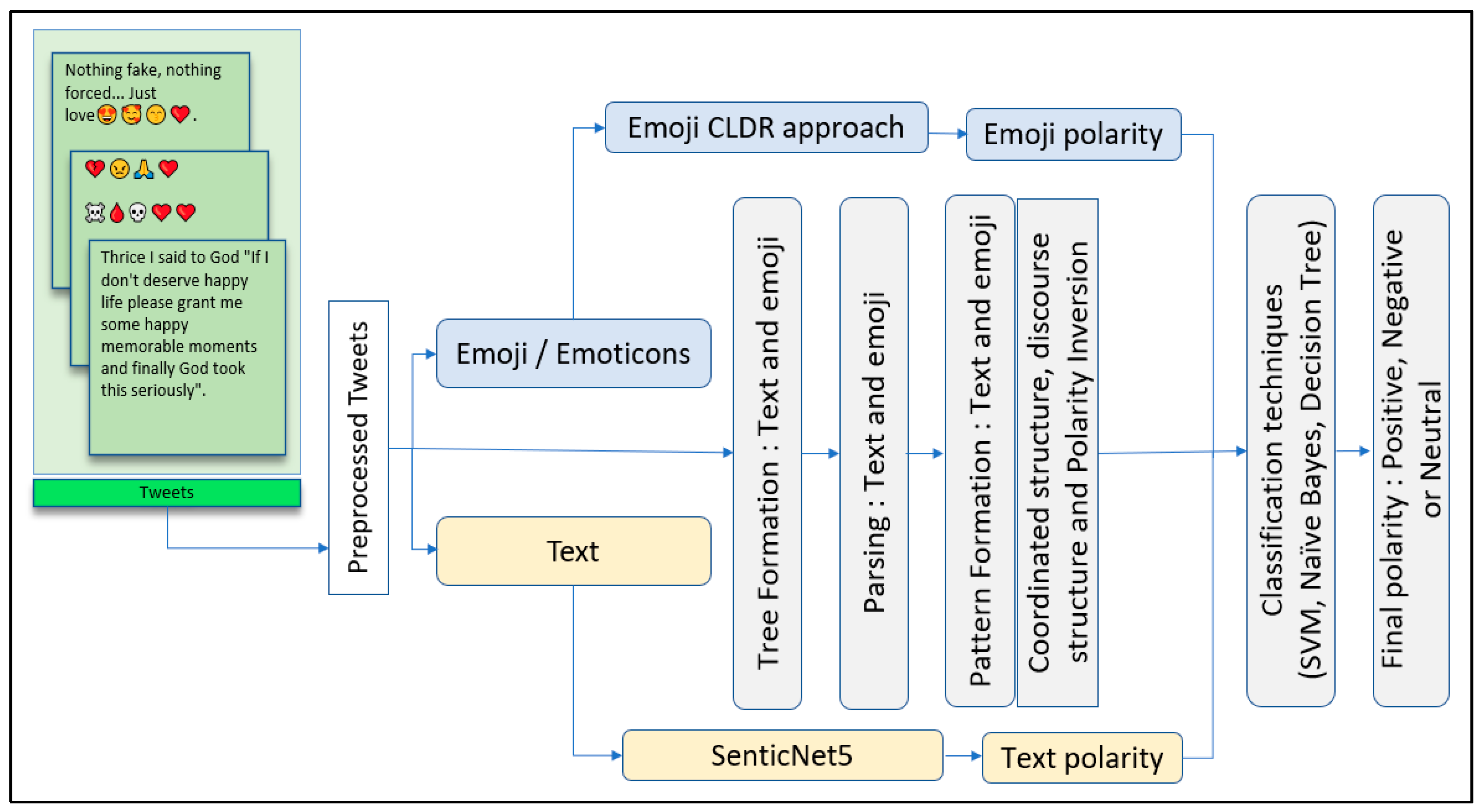
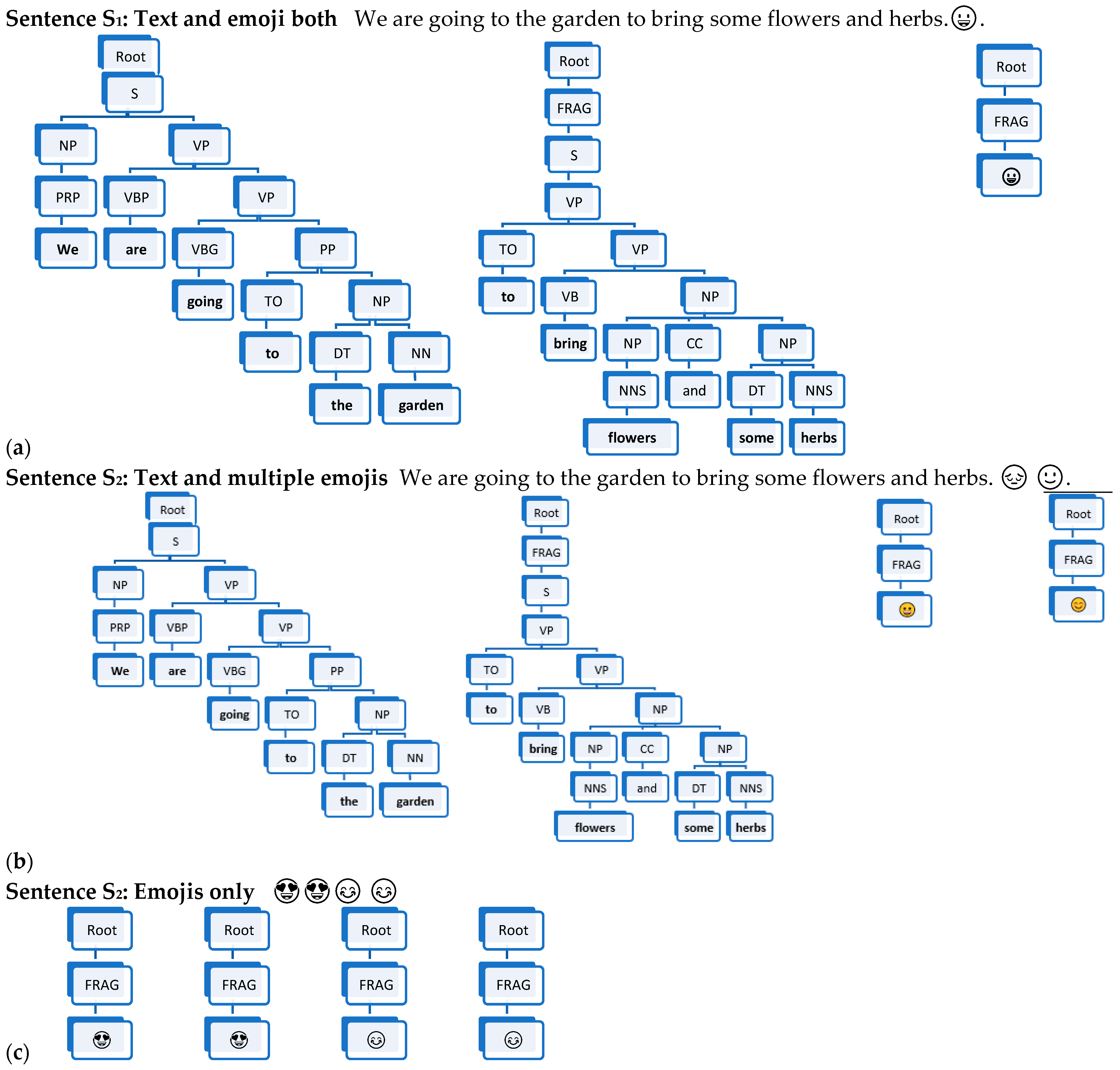
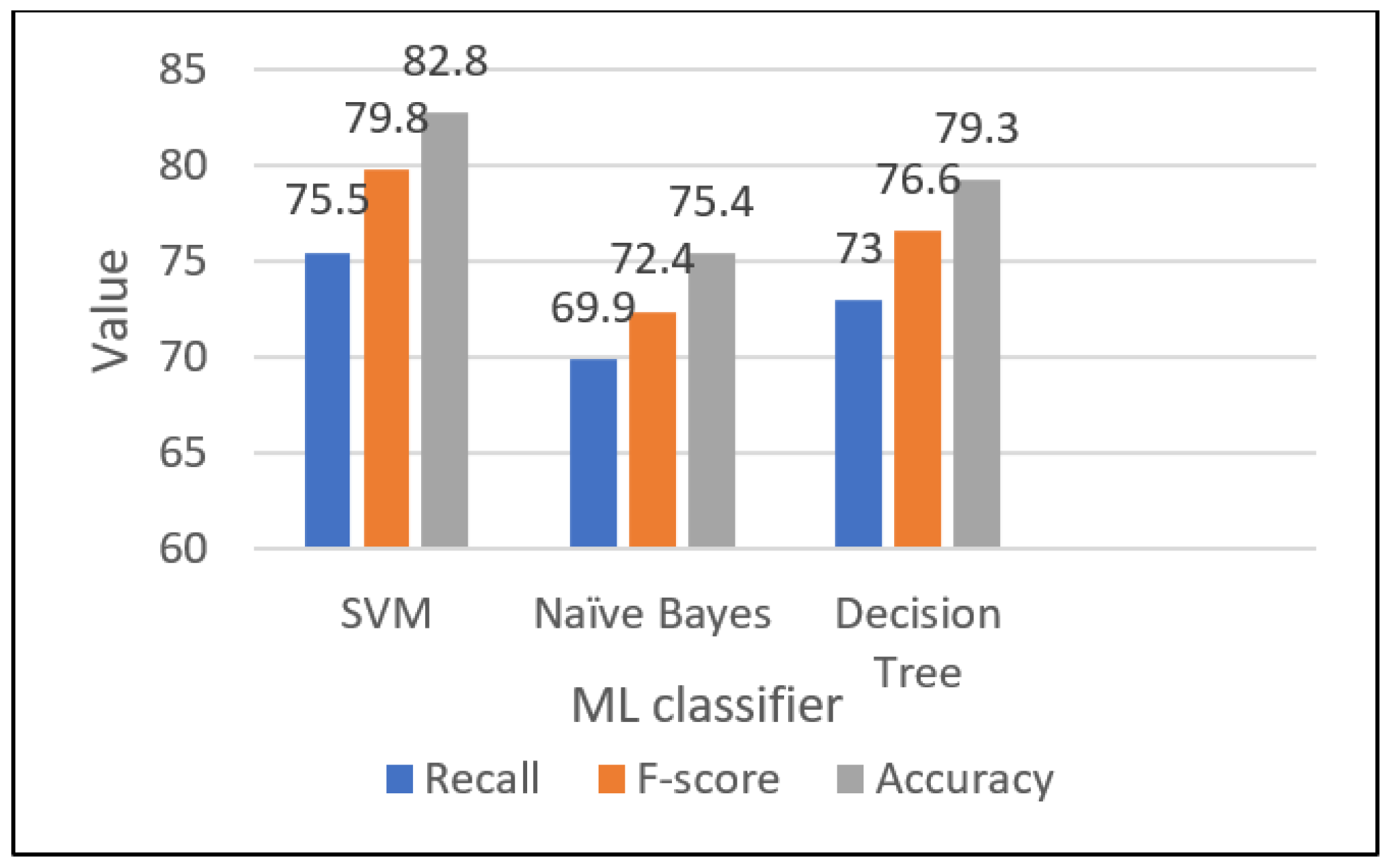
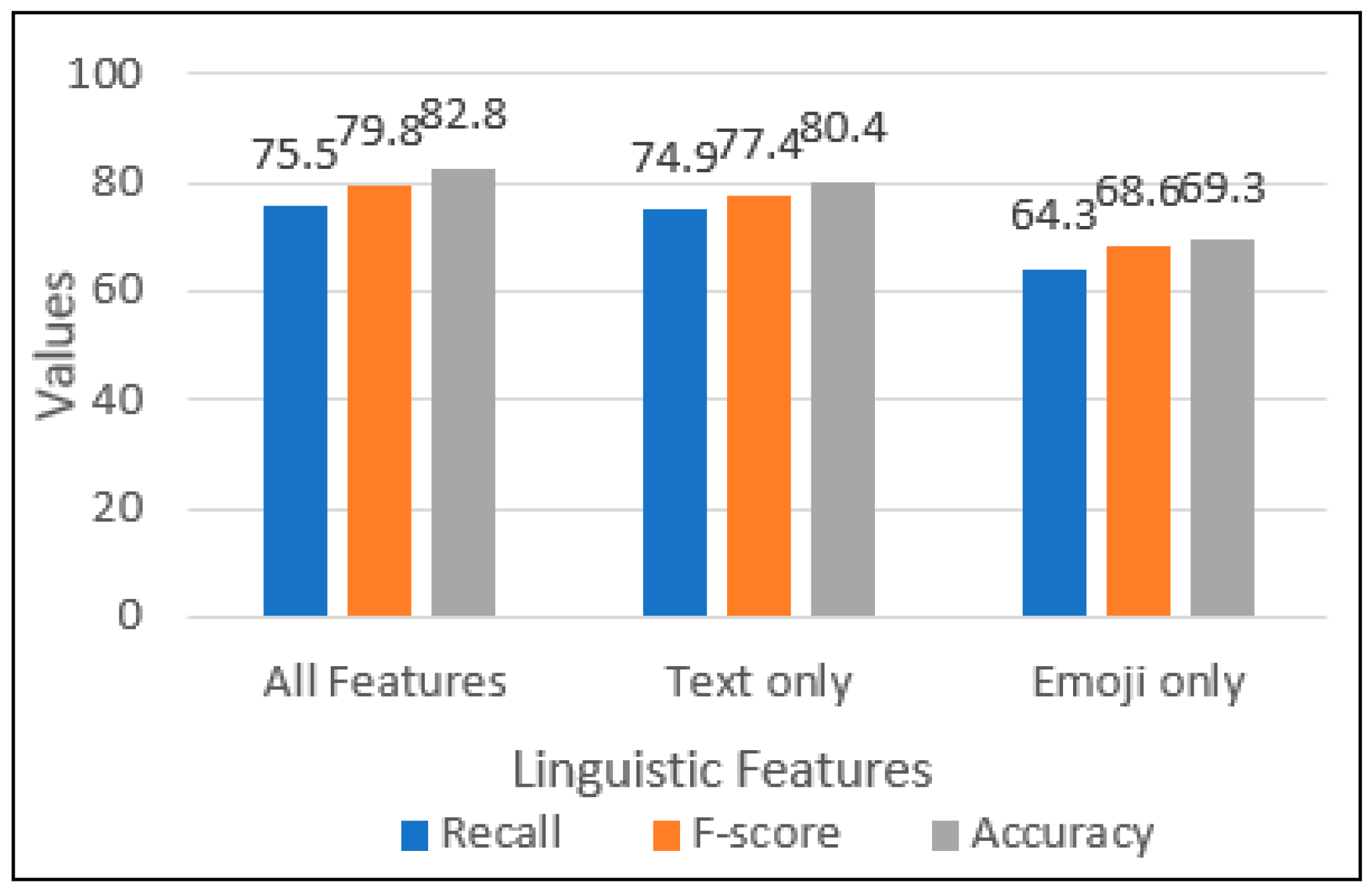
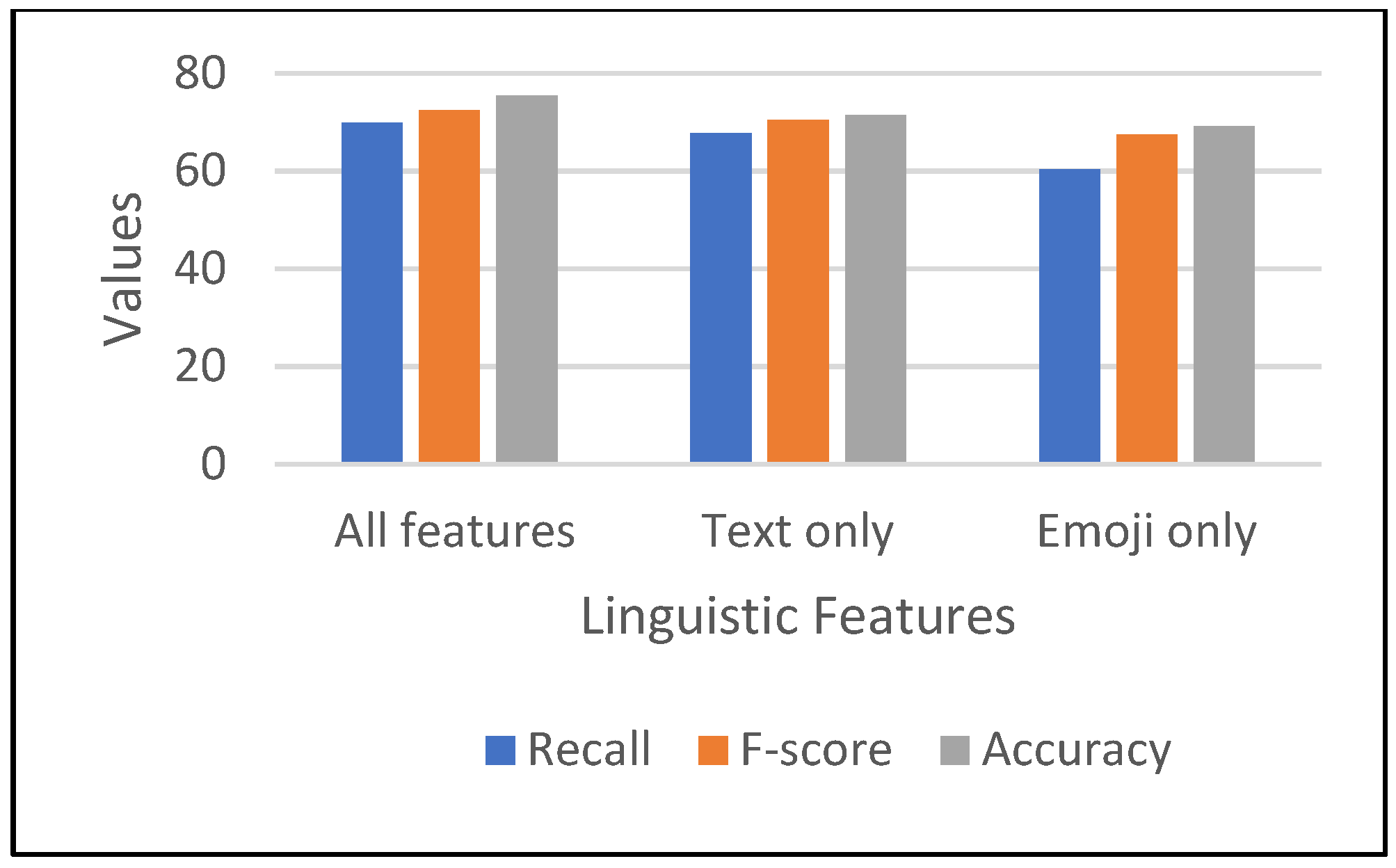
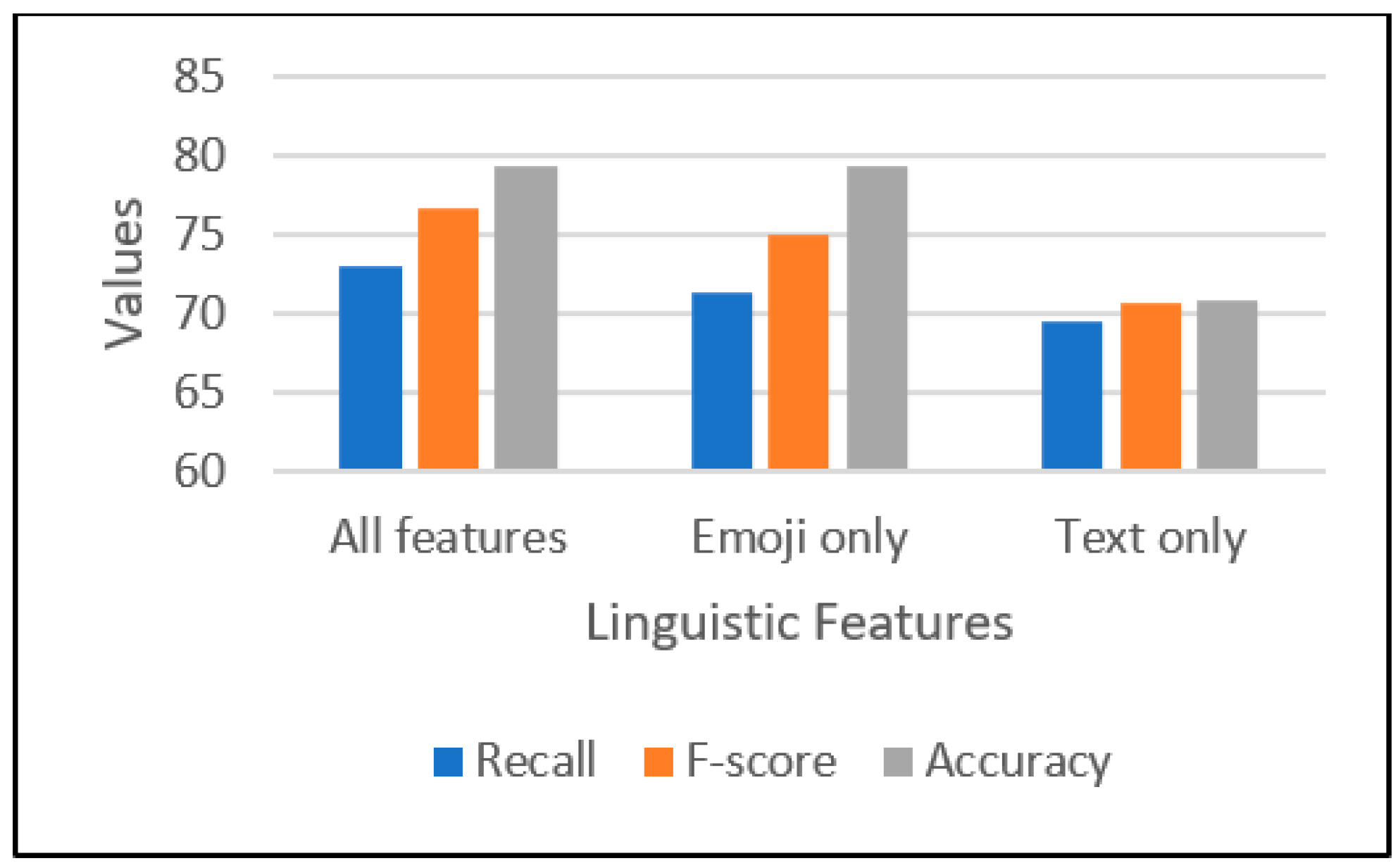
| POS Combinations | Description | Example |
|---|---|---|
| Text + Emoji | ||
| NOUN + EMOJI | Noun and emoji as standalone are added to concept | car 😊, laptop 💻, ice cream 😍. |
| NOUN + NOUN + EMOJI | Add two nouns as a single concept and emojis as separate. | ice-cream ☀️🤤, wheelchair 😭, chocolate biscuits 😋. |
| ADJ + NOUN + EMOJI | Adj + Noun as combinations is added to the objects list. Emoji as isolated are added to the concept. | expensive laptop 😍, beautiful car 🤩. |
| ADJ + STOPWORD + EMOJI | The adjective and emoji are added to concept. | lovely as ❤️ 🩸, sparking as 🤩. |
| NOUN + ADJ + EMOJI | In this pair, adjective, noun, and emoji as standalone are added as a valid concept. | man, big🌹, flower pink 🌻 |
| STOPWORD + NOUN + EMOJI | The stop word is discarded. The noun and emoji are considered valid. | as man 💪, this flower 🌻 👌. |
| STOPWORD + ADJ + EMOJI | Emoji and adjective are added as a standalone concept. | as beautiful 🌹 😍 🙂, being happy 😃 |
| Emoji only | ||
| Emojis | Each emoji is added as a standalone concept. | 🌹 😍 🙂 |
| Emojis | Each emoji is added as a standalone concept. | 😍 🙂 ✈️ 😒 😒 |
| Example | Text Polarity [45] | Emoji Polarity [23] | Proposed Approach Polarity |
|---|---|---|---|
| I like it 😀. | Pos. | Pos. | Pos. |
| I like it 😒. | Pos. | Neg. | Neutral |
| I do not like it | Neg. | NA | Neg. |
| I do not like it 😀. | Neg. | Pos. | Neutral |
| I did not appreciate it 😒. | Neg. | Neg. | Neg. |
| I do not hate it 😀. | Pos. | Pos. | Pos. |
| I do not dislike it 😒. | Pos. | Neg. | Neutral |
| Sentences | Text and Immediate Emoji Polarity Based on Proposed Approach | Remaining Emoji Polarity [23] | Proposed Approach Polarity |
|---|---|---|---|
| The guest house is not good to stay 🙂. | Neutral | - | Neutral + − = Neutral |
| The guest house is not good to stay 🙂 🙂 🙂. | Neutral | Pos. | Neutral + Pos. = Pos. |
| The guest house is not good to stay 😏 😏. | Neg. | Neg. | Neg. + Neg. = Neg. |
| The guest house is not good to stay 😏 🙂. | Neg. | Pos. | Neg. + Pos. = Neutral |
| Example | Left Conjunct [45] | Right Conjunct [45] | Emoji Polarity [23] | Text Polarity [45] | Proposed Approach |
|---|---|---|---|---|---|
| The jewel is lovely but costly 😂. | Pos. | Neg. | Pos. | Neg. | Neutral |
| The jewel is lovely but costly 😭. | Pos. | Neg. | Neg. | Neg. | Neg. |
| The jewel is lovely but not costly 😀. | Pos. | Pos. | Pos. | Pos. | Pos. |
| The jewel is lovely but not costly 😢. | Pos. | Pos. | Neg. | Pos. | Neutral |
| The jewel is lovely but <cough cough cough> 😀. | Pos. | undefined | Pos. | Neg. | Neutral |
| The jewel is lovely but <cough cough cough> 😭. | Pos. | undefined | Neg. | Neg. | Neg. |
| The jewel is not lovely but <cough cough cough> 😀. | Neg. | undefined | Pos. | Pos. | Pos. |
| The jewel is not lovely but <cough cough cough> 😭. | Neg. | undefined | Neg. | Pos. | Neutral |
| <cough cough cough> but the bike is sporty 😭. | undefined | Pos. | Neg. | Pos. | Neutral |
| <cough cough cough> but the bike is sporty 😀. | undefined | Pos. | Pos. | Pos. | Pos. |
| <cough cough cough> but the bike is costly 😭. | undefined | Neg. | Neg. | Neg. | Neg. |
| <cough cough cough> but the bike is costly 😀. | undefined | Neg. | Pos. | Neg. | Neutral |
| Sentences | Text and Immediate Emoji Polarity Based on Proposed Approach | Remaining Emoji Polarity [23] | Proposed Approach Polarity |
|---|---|---|---|
| The guest house is good to stay but the room size is small 🙂 🙂 🙂. | Neutral | Pos. | Neutral + Pos. = Pos. |
| I wish you very Happy Anniversary but without party 😟 😟?? | Neg. | Neg. | Neg. + Neg. = Neg. |
| She dances very beautifully but her dress was also awesome 😜 😜. | Neutral | Neg. | Neutral + Neg. = Neg. |
| She dances very beautifully but 😜 😜. | Neg. | Neg. | Neg. + Neg. = Neg. |
| Sentences | Text Polarity [45] | Proposed Approach | Accurate Polarity |
|---|---|---|---|
| The guest house is good to stay but the room size is small 🙂 🙂 🙂. | Neg. | Pos. | Pos. |
| I wish you very Happy Anniversary!!! Party 😟 😟?? | Pos. | Neg. | Neg. |
| She dances very beautifully 😈 😈 😈. | Pos. | Neg. | Neg. |
| The idea was not good 🤪 | Neg. | Neutral | Neutral |
| ML Classifier | Linguistic Features | Recall | F-Score | Accuracy |
|---|---|---|---|---|
| SVM | Text only, emoji only, and combination of text with emoji (Proposed approach: All features) | 75.5 | 79.8 | 82.8 |
| Text only | 74.9 | 77.4 | 80.4 | |
| Emoji only | 64.3 | 68.6 | 69.3 | |
| Naïve Bayes | Text only, emoji only and combination of text with emoji (Proposed approach: All features) | 69.9 | 72.4 | 75.4 |
| Text only | 67.7 | 70.4 | 71.4 | |
| Emoji only | 60.3 | 67.5 | 69.2 | |
| Decision Tree | Text only, emoji only and combination of text with emoji (Proposed approach: All features) | 73 | 76.6 | 79.3 |
| Text only | 71.3 | 74.9 | 79.3 | |
| Emoji only | 69.5 | 70.6 | 70.8 |
| Approach | But and Adversatives Accuracy | Polarity Inversion Accuracy |
|---|---|---|
| Poria et al. [45] | 87.9% | 88.6% |
| Socher et al. [7] | 56.6% | 64.4% |
| Proposed approach | 90.78% | 92.12% |
Disclaimer/Publisher’s Note: The statements, opinions and data contained in all publications are solely those of the individual author(s) and contributor(s) and not of MDPI and/or the editor(s). MDPI and/or the editor(s) disclaim responsibility for any injury to people or property resulting from any ideas, methods, instructions or products referred to in the content. |
© 2023 by the authors. Licensee MDPI, Basel, Switzerland. This article is an open access article distributed under the terms and conditions of the Creative Commons Attribution (CC BY) license (https://creativecommons.org/licenses/by/4.0/).
Share and Cite
Gupta, S.; Singh, A.; Kumar, V. Emoji, Text, and Sentiment Polarity Detection Using Natural Language Processing. Information 2023, 14, 222. https://doi.org/10.3390/info14040222
Gupta S, Singh A, Kumar V. Emoji, Text, and Sentiment Polarity Detection Using Natural Language Processing. Information. 2023; 14(4):222. https://doi.org/10.3390/info14040222
Chicago/Turabian StyleGupta, Shelley, Archana Singh, and Vivek Kumar. 2023. "Emoji, Text, and Sentiment Polarity Detection Using Natural Language Processing" Information 14, no. 4: 222. https://doi.org/10.3390/info14040222
APA StyleGupta, S., Singh, A., & Kumar, V. (2023). Emoji, Text, and Sentiment Polarity Detection Using Natural Language Processing. Information, 14(4), 222. https://doi.org/10.3390/info14040222









